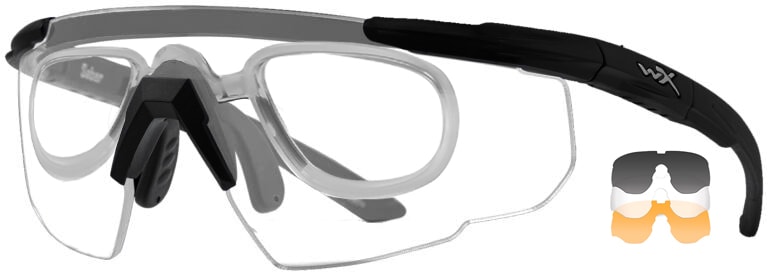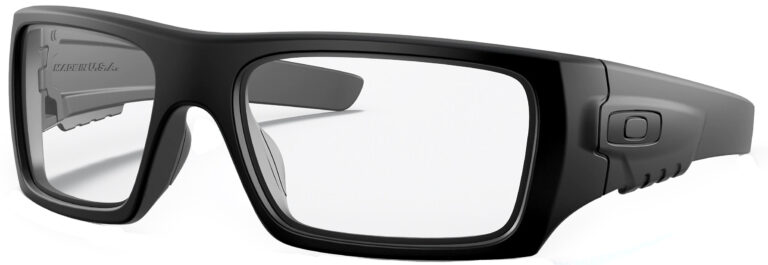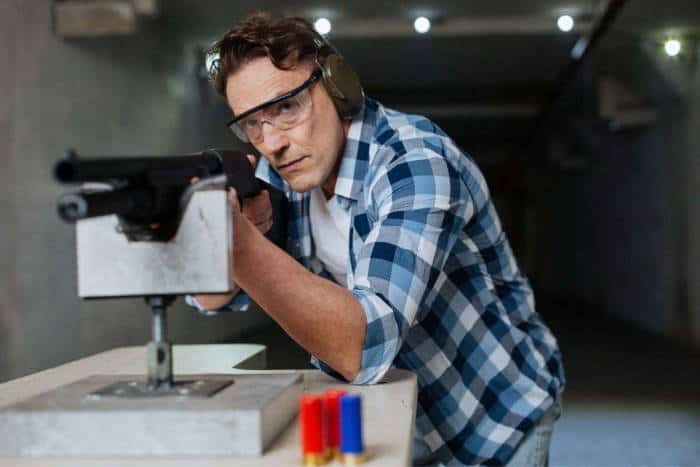
Any tactical activity requires dependable safety gear, and up there in priority is protecting your eyes. Whether you’re at target practice, hunting, or playing Airsoft, you need excellent visual clarity, high-velocity impact resistance, and protection from wind, debris, and errant projectiles that may come your way.
Plenty of excellent safety glasses abound, but what if you can’t see clearly without prescription glasses? Don’t worry – you don’t need to wear contact lenses if you don’t want to. We’ve got the top picks for the best prescription shooting glasses to keep the sharpshooter in you sharp.
(This page contains affiliate links. OGR may receive compensation if you click a link and make a purchase.)
Best Prescription Shooting Glasses
Wiley X Saber
A top pick on nearly everyone’s list, the Wiley X Saber is a shield-style pair of safety glasses that meets military ballistic (MIL-PRF-32432(GL)), ANSI-Z87.1, and federal OSHA standards for high-velocity impact.
The Rx-insert is a separate piece that clips in behind the shield above the nosepiece. The nice thing about this setup is if your prescription changes, there’s no need to get a new pair – just replace the insert with updated lenses.
It’s tops for coverage, comfort, and excellent distortion-free clarity all around. Take your pick of interchangeable lenses including clear, smoke gray, yellow, or other tints. With Wiley X’s reputation for excellent safety eyewear at reasonable prices, this one’s a winner amongst winners.
ESS Crossbow Suppressor One
The ESS Crossbow Suppressor is an excellent choice for clay shooting, especially under low light conditions with the Hi-Def Copper lens.
It’s also great for Airsoft, and the specially-designed thin temples fit perfectly under earmuffs or headsets. Some users forget they’re even wearing the Crossbow Suppressor, that’s how comfortable and unobtrusive it is.
It’s fully compliant with both civilian and military ballistic standards, and comes with a safety strap that snaps onto the temple tips for extra security. The interchangeable shield lens is secured in place with ESS’ Dedbolt Lens Lock, so there’s no concern that it might come loose after swapping in a different lens.
The ESS Rx-insert clips in behind the shield and is compatible with multiple ESS frames.
Smith Optics Aegis Echo II Compact
Another great choice for wearing under ear protection, Smith Optic’s Aegis Echo II Compact is a smaller, better-fitting version for many who find the Aegis Echo II too roomy.
It has a super lightweight build with thin aluminum temples and excellent optics. Plus it’s easy to switch out the shield, which isn’t always the case with other PPE.
It’s US MIL-PRF-31013 standard and ANSI Z87.1 rated so you’re well-protected against any hazard, and the lens is impressively scratch-resistant. It doesn’t fog up easily either.
The Rx-insert mounts inside the lens on top of the nosepiece and is also compatible with Smith’s OTW Goggles. Lastly, the Aegis Echo II also comes in Asian Fit for those with flatter nose bridges and higher cheekbones.
Best Prescription Safety Glasses
Oakley SI Det Cord
If you prefer a full-rim frame that you can wear anywhere without screaming “I just left the shooting range!”, the always dependable Oakley Standard Issue Det Cord is just the ticket. Made of Oakley’s famous O Matter™ material, the Det Cord meets MIL PRF 32432 and surpasses ANSI Z87.1 standards for eye protection.
In addition to the reliable, lightweight frame, Oakley puts their awesome Unobtanium rubber that gets tackier with moisture on the nose pad. Even if you sweat up a storm, these babies stay put. Best of all, Rx lenses are inserted straight into the frame itself so the entire lens area provides corrective vision.
What To Look For In Prescription Shooting Glasses
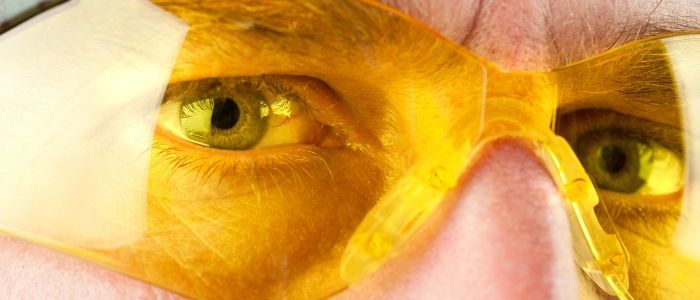
Lens material
According to Newton’s third law of physics, every action will have an equal and opposite reaction. When you unload a high-power bullet from a gun barrel, the exact same force will come out the other end of the gun as well, often with some residue or powder.
If you want to protect your eyes from any possible debris or hazard on the range or in the field, you need something that can withstand a large amount of force without shattering. With that in mind, let’s go over the materials you should look for in a proper pair of shooting glasses.
Polycarbonate Lenses
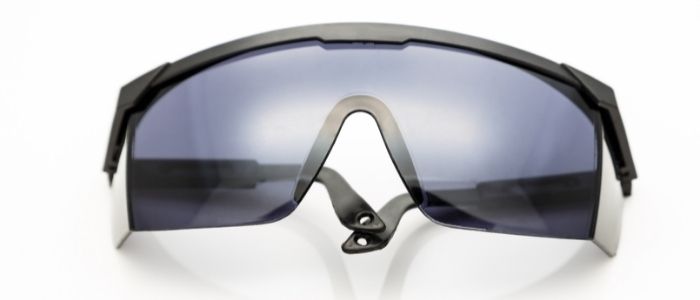
The most common safety and shooting lens material, polycarbonate is a lightweight, durable, and impact-resistant thermoplastic that has many uses beyond optical lenses.
The aerospace industry was the first to pioneer polycarbonate. It was used to make helmet visors for astronauts and windshields for planes and spacecraft. Regardless of the application, the main characteristics are how lightweight it is and being nearly shatter-proof.
Given these properties, polycarbonate lenses are great for children, youth, and sports and safety glasses.
Polycarbonate lenses are about 20-25% thinner than plastic lenses, and 10 times more impact resistant. Its impact resistance is due to its softness, and the fact that it bends easily without cracking.
Another benefit: polycarbonate is inherently 100% UV-blocking. So if you work or play outside, you don’t need any additional UV-coatings to protect your eyes from harmful UVA/UVB rays.
Trivex Lenses

Trivex lenses have similar properties to polycarbonate in that they are shatter-resistant and lightweight. As a matter of fact, Trivex is even lighter than polycarbonate by about 10%. It also has sharper optical clarity due to the material’s higher Abbe value.
Trivex lenses tint more easily than polycarbonate for those looking to add yellow or other colors to enhance contrast.
Some optical shops offer Trivex lenses as an option, particularly if you’re ordering a custom pair of prescription tactical glasses. It’s more expensive than polycarbonate, so it will increase the overall cost of a pair of safety glasses.
Safety Rating
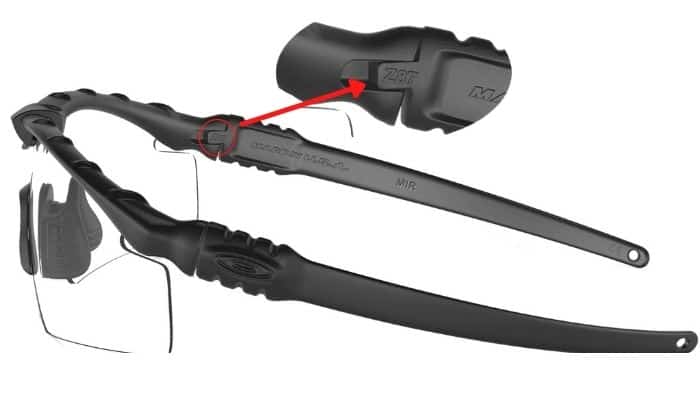
Besides lens material, the most important thing to look for in a pair of shooting glasses is the safety rating.
At a minimum, you want an ANSI-Z87 rated pair of glasses. The American National Standards Institute (ANSI) designates the Z87.1 standard for protective civilian eyewear. While the Z87.1 rating designates the basic safety rating, an additional “+” symbol, or Z87+, means it is rated for high-velocity impact.
Both the frames and the lenses are assessed for this standard, which is important.
An ANSI-Z87 certified pair can be used for a large array of activities that may incur debris or other hazardous material that could cause damage to your eyes if not protected.
In addition to civilian standards, the military has the MIL-PRF32432 Ballistic Fragmentation standard. This rating is similar to the Z87 from ANSI, but is much more stringent.
As a general rule of thumb, most military-grade glasses and goggles will meet ANSI standards since they actually exceed civilian requirements.
Lens Colors/Coatings
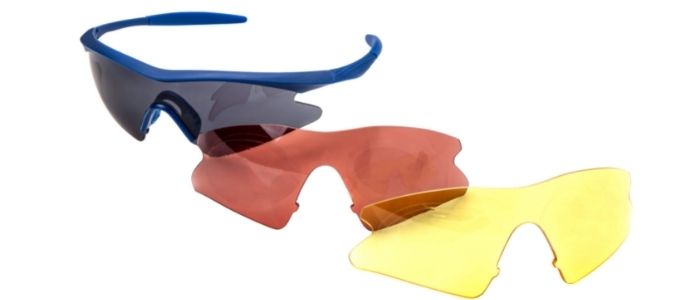
Certain pieces of protective gear simply look cool, and glasses are by far the coolest. For the uninitiated, the wide variety of lens colors are just an aesthetic choice. But when it comes to finding your target quickly, the right tint can help reduce haze and enhance contrast.
In fact, due to the properties and wavelengths of light rays, specific colors have specific benefits. For example, purple-ish lenses are held to distinguish targets present on a green background with a lot of vegetation.
Darker colors are best for well-lit situations, as they help you distinguish individual sections of the target. Meanwhile, lighter lenses help you adapt to low-light conditions.
Orange lenses are pretty popular, favored by those targeting stationary targets or skeet shooting.
The most popular tint is yellow for its blue-light blocking capabilities, sharpening borders and outlines between objects and targets and enhancing overall contrast.
As many a marksman or hunter knows, you often have to deal with two major environmental factors: fog and light glare. When customizing lenses for your prescription shooting glasses, you can combat these by adding an anti-reflective or anti-fog coating.
Frame and Fit
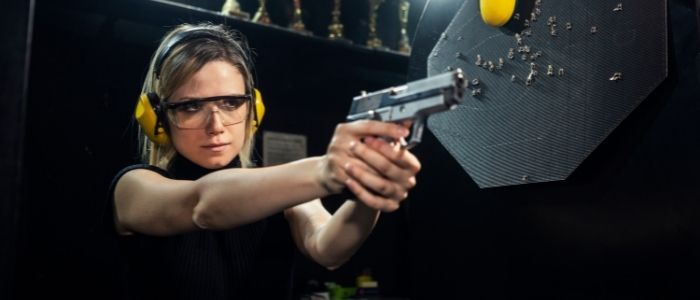
You can’t afford to deal with cumbersome eyewear while at the range or out hunting. Regardless of their material or brand, shooting glasses must be streamlined and lightweight. And, they must stay securely in place without adding pressure to the sides of your head.
The most popular frame materials include titanium, plastic, and aluminum. All three are flexible, durable and lightweight. Titanium frames can be the most expensive, but they are extremely strong, flexible, and corrosion-resistant.
Of course, protective eyewear should have at least an ANSI-Z87 stamp or better (MILSPEC) for true impact protection.
Other features to consider are flexible nose pads that you can adjust to your face and rubber grips on the temples and nose piece for a secure grip.
Prescription Shooting Glasses FAQs
Can I wear Regular Prescription Glasses for Shooting?
Prescription glasses are very good at what they were made to do: correct vision issues. However, they were not made to withstand high-impact forces of small bits of matter flying at them. They can break, crack, or shatter, sending shards into your eyes if broken.
For true protection, an ANSI-certified (or better) pair of safety glasses with polycarbonate lenses are recommended to ensure complete protection from all angles.
Why Are There Different Lens Colors In Shooting Glasses?
Each color compensates or complements specific lighting and environments. As mentioned, lighter colors tend to work better in low-light conditions, because darker shades can make it more difficult to see.
Purple is ideal for motion detection on a green background, while yellow is excellent for low light and enhancing contrast.
Clear and grey lenses offer the least drawbacks in any situation, making them the most versatile.
Which Lens Color is Best For Shooting?
It depends on the environment you’re in, as well as lighting conditions.
Clear lenses are the most reliable because they are decent overall, orange is best for static range shooters, purple suits hunters well, while military and police can benefit from yellow tints.
How Do I Know If My Safety Glasses Meet ANSI Safety Ratings?
Check the temple arms for “Z87”. If you see the marking or engraving, your shooting glasses meet the ANSI Z87.1 standard. If it’s not marked, the glasses are not ANSI-certified for mass or impact protection.
Should I Get Transitions/Photochromic Lenses?
If you move from indoor to outdoor areas fairly frequently, it might be preferable to get photochromic lenses that darken or lighten depending on the lighting. This way you can keep your safety glasses on without losing visuals from one environment to another.
Are Polycarbonate Sports Glasses Safe For Use at the Shooting Range?
They’re certainly better than the naked, unprotected eye. The rest depends on their accreditation. If your glasses meet ANSI standards or above, they will be safe. If not, you have no guarantee that they won’t shatter, break, or let debris fly into your eye.
